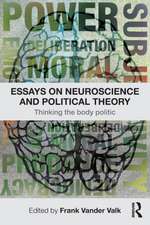The Molecular Biology of Physarum polycephalum: NATO Science Series A:, cartea 106
Autor William F. Dove, Jennifer Dee, Sadashi Hatano, Finn B. Haugli, Karl-Ernst Wohlfarth-Bottermannen Limba Engleză Paperback – 12 dec 2012
Din seria NATO Science Series A:
- 15%
 Preț: 656.58 lei
Preț: 656.58 lei - 15%
 Preț: 655.13 lei
Preț: 655.13 lei - 15%
 Preț: 678.35 lei
Preț: 678.35 lei -
 Preț: 397.38 lei
Preț: 397.38 lei - 5%
 Preț: 377.87 lei
Preț: 377.87 lei -
 Preț: 397.76 lei
Preț: 397.76 lei - 18%
 Preț: 1232.41 lei
Preț: 1232.41 lei - 5%
 Preț: 731.64 lei
Preț: 731.64 lei -
 Preț: 413.15 lei
Preț: 413.15 lei - 5%
 Preț: 369.45 lei
Preț: 369.45 lei -
 Preț: 407.56 lei
Preț: 407.56 lei - 5%
 Preț: 2162.19 lei
Preț: 2162.19 lei -
 Preț: 407.39 lei
Preț: 407.39 lei -
 Preț: 396.40 lei
Preț: 396.40 lei - 15%
 Preț: 663.93 lei
Preț: 663.93 lei -
 Preț: 387.38 lei
Preț: 387.38 lei -
 Preț: 393.13 lei
Preț: 393.13 lei -
 Preț: 398.35 lei
Preț: 398.35 lei -
 Preț: 401.24 lei
Preț: 401.24 lei - 15%
 Preț: 678.81 lei
Preț: 678.81 lei -
 Preț: 395.09 lei
Preț: 395.09 lei - 18%
 Preț: 952.40 lei
Preț: 952.40 lei - 15%
 Preț: 654.43 lei
Preț: 654.43 lei -
 Preț: 402.00 lei
Preț: 402.00 lei -
 Preț: 401.24 lei
Preț: 401.24 lei - 15%
 Preț: 655.27 lei
Preț: 655.27 lei -
 Preț: 394.71 lei
Preț: 394.71 lei -
 Preț: 384.48 lei
Preț: 384.48 lei - 5%
 Preț: 395.61 lei
Preț: 395.61 lei - 5%
 Preț: 1421.57 lei
Preț: 1421.57 lei - 15%
 Preț: 651.34 lei
Preț: 651.34 lei -
 Preț: 400.10 lei
Preț: 400.10 lei -
 Preț: 386.99 lei
Preț: 386.99 lei - 5%
 Preț: 386.11 lei
Preț: 386.11 lei -
 Preț: 403.91 lei
Preț: 403.91 lei - 15%
 Preț: 651.51 lei
Preț: 651.51 lei -
 Preț: 393.90 lei
Preț: 393.90 lei - 5%
 Preț: 376.43 lei
Preț: 376.43 lei -
 Preț: 400.26 lei
Preț: 400.26 lei - 5%
 Preț: 388.84 lei
Preț: 388.84 lei -
 Preț: 400.65 lei
Preț: 400.65 lei - 5%
 Preț: 740.58 lei
Preț: 740.58 lei - 18%
 Preț: 1225.16 lei
Preț: 1225.16 lei - 5%
 Preț: 386.46 lei
Preț: 386.46 lei -
 Preț: 421.82 lei
Preț: 421.82 lei
Preț: 649.22 lei
Preț vechi: 763.78 lei
-15% Nou
Puncte Express: 974
Preț estimativ în valută:
124.22€ • 129.70$ • 102.81£
124.22€ • 129.70$ • 102.81£
Carte tipărită la comandă
Livrare economică 04-18 aprilie
Preluare comenzi: 021 569.72.76
Specificații
ISBN-13: 9781461292944
ISBN-10: 1461292948
Pagini: 384
Ilustrații: IX, 368 p. 90 illus.
Dimensiuni: 178 x 254 x 20 mm
Greutate: 0.66 kg
Ediția:Softcover reprint of the original 1st ed. 1986
Editura: Springer Us
Colecția Springer
Seria NATO Science Series A:
Locul publicării:New York, NY, United States
ISBN-10: 1461292948
Pagini: 384
Ilustrații: IX, 368 p. 90 illus.
Dimensiuni: 178 x 254 x 20 mm
Greutate: 0.66 kg
Ediția:Softcover reprint of the original 1st ed. 1986
Editura: Springer Us
Colecția Springer
Seria NATO Science Series A:
Locul publicării:New York, NY, United States
Public țintă
ResearchCuprins
1: Introduction to Physarum.- Position Papers.- 2: Genetic Analysis in Physarumpolycephalum.- 3: Molecular Organization of the Physarum Genome.- 4: Temporal Order of Replication and Gene Expression in Physarumpolycephalum.- 5: The Physarum Cell Cycle.- 6: Cellular Transformations of Myxamoebae.- 7: Gene Expression During Plasmodial Differentiation.- 8: Biological Aspects of Motility.- 9: Actin, Myosin, and the Associated-Proteins from the Physarum Plasmodium.- Motility: Experimental Investigations.- 10: Inhibitory Ca2+-Regulation of the Physarum Actomyosin System.- 11: Physarum Myosin Binds Ca2+: Results from Electrophoresis and Equilibrium Dialysis Experiments.- 12: Kinetics of Modulator-Actin Interactions: A Comparison of Physarum Fragmin with Actin Modulators from Different Muscle Types.- 13: A Nonpolymerizable Actin Derivative Regulates Actin Polymerization by Capping the Fast-Growing End of Actin Filaments.- 14: Dynamics and Function of Microfilaments in Physarumpolycephalum as Revealed by Fluorescent Analog Cytochemistry (FAC) and Electron Microscopy.- 15: A Titin-like Protein is Present in Physarumpolycephalum — Present Knowledge.- 16: Isolation of a Native Connectin-Like Protein from the Plasmodium of Physarumpolycephalum and its Interaction with Myosin and Actin.- Technical Feasibilities.- 17: To Bring Molecular Genetics to the Study of Biological Motility in Physarum.- 18: The Culture of Physarum Amoebae in Axenic Media.- 19: A New Method for the Preparation of Highly Purified and More Native Nuclei Showing Stage-Specific Transcription of Actin and Tubulin Genes.- 20: Incorporation of Substances into Living Cells.- 21: Protocol for Microinjection of Macroplasmodia of Physarumpolycephalum.- 22: Gene Cloning and Construction of Genomic Libraries in Physarum.-23: Gene Cloning and Construction of cDNA Libraries in Physarum.- 24: cDNA Cloning of Physarumpolycephalum Stage-Specific mRNAs.- 25: Toward a DNA Transformation System for Physarumpolycephalum.- Epilogue: Physarum as an Integrated Experimental Organism.- Abbreviations.- Participants and Contributors.










